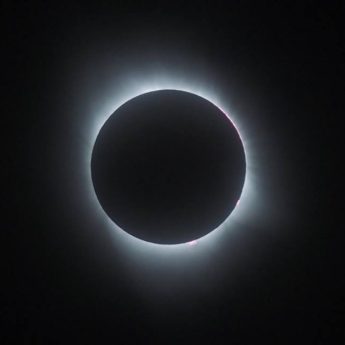This Week’s Sky at a Glance, 2024 April 6 – April 13

This Week’s Sky at a Glance, 2024 April 6 – April 13
I guess everyone knows what the topic is for this week. On Monday afternoon the central half of the province will be treated to a total eclipse of the Sun. The northern limit runs from just above Grand Falls to just below Bathurst; the southern limit runs from McAdam, to south of Oromocto and just north of most of Moncton; and the centre of the Moon’s shadow, where totality is longest at about 200 seconds, runs near Hartland, Doaktown and Rogersville. Totality time will decrease from the centreline toward the northern and southern limits. Areas outside of the limits will get a deep partial eclipse, about 99% covered.
Between about 3:24 and 4:34 pm the Moon will slide across the Sun from lower right to upper left. During this time the sky will darken, the temperature will drop by several degrees (be prepared) and the wind will likely get stronger. Toward the end of this phase notice how birds prepare for an early night. Seconds before the Moon covers the Sun completely, look for its shadow approaching from the west, the twinkling of sunlight between lunar mountains and craters (Baily’s beads), and the final flash of light known as the diamond ring effect.
During the brief totality we see the Sun’s pearly white corona surrounding the Moon, declared by many to be the most spectacular sight in Nature and probably the rarest. It has not occurred for Fredericton and Moncton in 11 centuries. Look for a 360-degree colourful twilight horizon, and for the brighter planets and stars to appear. Totality ends all too soon with the reappearance of the diamond ring and Baily’s beads, followed by 70 minutes of the partial phase in reverse.
Eclipse glasses have been given out to many residents of the province, and hopefully they will share with others. Use them for up to a couple of minutes at a time to check on the Moon’s passage across the Sun at all times during the partial phases of the eclipse. DO NOT use them to look at the Sun through binoculars or a telescope; permanent eye damage will result. During the brief totality it is safe to watch without the eye protection; you won’t see the corona or anything else with them on. Put them on as soon as the Sun reappears from behind the Moon.
This Week in the Solar System
Saturday’s sunrise in Moncton is at 6:48 and sunset will occur at 7:55, giving 13 hours, 7 minutes of daylight (6:54 and 7:50 in Saint John). Next Saturday the Sun will rise at 6:35 and set at 8:04, giving 13 hours, 29 minutes of daylight (6:41 and 8:08 in Saint John).
The Moon is below Saturn and Mars in twilight this Saturday morning, a nice challenge for binocular observers. It is new, of course, on Monday afternoon, briefly blocking the Sun to varying degrees around the province, and on Wednesday evening it is near Jupiter and Uranus. Mercury reaches inferior conjunction on Thursday, moving into the morning sky later in the month. Mars and Saturn get cozy late in the week, appearing side-by-side on Thursday morning. Venus is getting too close to the Sun for comfortable viewing as it crawls toward superior conjunction in early June. By the end of the week comet 12P/Pons-Brooks will be within a binocular view to the lower right of Jupiter and near maximum brightness. Uranus is also within a binocular view to Jupiter’s upper left.
The Fredericton Astronomy Club meets in the UNB Forestry-Earth Sciences building on Tuesday at 7 pm. The next meeting of the Saint John Astronomy Club will be at the Rockwood Park Interpretation Centre on April 13 at 7pm.
